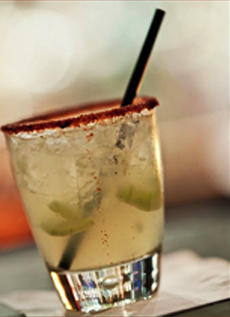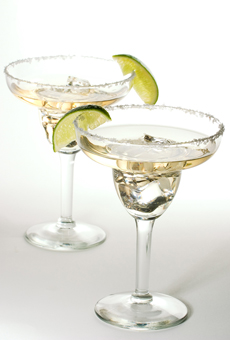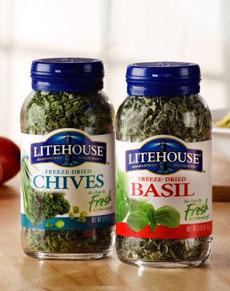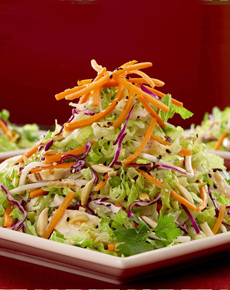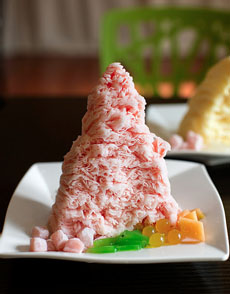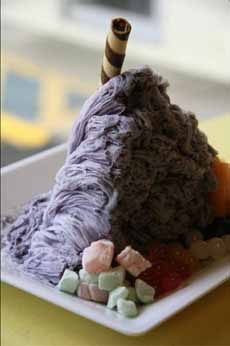|
Don’t expect dessert: You’re making a sandwich.
Tartine is the French word for an open-faced sandwich with a rich spread or fancy topping; the word actually refers to a slice of bread. Tartine is the French diminutive of the Old French and Middle English tarte, derived from the Late Latin torta, a type of bread. (Yes, we’re culinary history geeks.)
Beyond the occasional open face roast beef or turkey sandwich with gravy, open face sandwiches are no longer in fashion in the U.S.
We have a vague childhood recollection of a variety of tartines served in the ladies’ lunch restaurants our grandmother frequented. Eaten with a knife and fork, they were in tune with those more gracious (and graceful) times. Our mother continued the tradition, serving them at home.
But slapping another slice of bread on top of the ingredients for a conventional sandwich is more American: faster and more convenient to eat, if less elegant.
Tartines remain a traditional sandwich type in the Nordic countries: Estonia, Latvia, Lithuania, The Netherlands, Poland and Russia, where they are eaten at breakfast, lunch, dinner or as a snack.
The Netherlands: The uitsmijter, often served as a hearty breakfast, is white bread topped with a selection of meats, cheeses, vegetables and sometimes an egg.
|
|

Brandade (here, a combination of mashed potatoes and cod), oven roasted cherry tomatoes, vinaigrette-dressed arugula on white toast. Photo courtesy Chocolate Lab | San Francisco. |
|
Scandinavia: The Scandinavian open-face sandwich (smorrebrod in Denmark, voileipä in Finland, morbrod in Norway, smorgas in Sweden) tops a slice of buttered whole-grain rye with just about anything. A selection of proteins—bacon, caviar, herring, fish fillets, hard boiled eggs, liver pâté, meatballs, sliced steak, shrimp, smoked salmon—are complemented by herbs and/or vegetables, such as parsley, pickled beets, sliced cucumber, salad, tomatoes. Mayonnaise or a mayonnaise-based dressing is often included.
Breakfast tartines: Popular in Belgium and The Netherlands, these are most likely to make the transition to American kitchens. Some of us already serve bread or toast with chocolate spread, honey, jam, peanut butter and bananas or other sliced fruit.
READY TO MAKE TARTINES?
Suggested ingredients are below. Start with these tips:
Use large, thicker slices of quality bread—cut them in half before serving.
Toast the bread—it provides a sturdier “raft” for the sandwich.
Melt the cheese—even a slight amount of melting enhances the consistency of the sandwich.
Check out the leftovers—they’re perfect for tartines, because you don’t need large pieces or a large amount of any one ingredient.
Serve at room temperature or warmed.
|
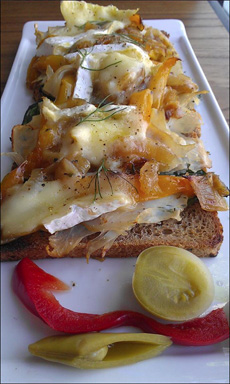
Turkey, brie, onion-pepper marmalade
roasted yellow bell pepper and fresh dill, with
a side of pickled vegetables. Photo courtesy
Chocolate Lab | San Francisco. |
|
TARTINE INGREDIENTS: MIX & MATCH
Proteins
Bacon, prosciutto, serrano ham (we also like leftover roast pork)
Cheese: herbed goat or other cheese spread, favorite sliced cheese (like Emmental/Swiss) or crumbled cheese
Cold cuts, charcuterie/salume, hard-boiled eggs
Smoked salmon, gravlax
Seafood: crab, lobster, shrimp, sliced scallops
Vegetarian Ingredients
Onions: caramelized onions or onion marmalade, chives, pickled onions, thin-sliced red or sweet onions
Fresh or marinated vegetables, sliced thin: avocado, beets, carrots (shredded or curled), cole slaw in vinaigrette, cucumber, radish, shaved fennel
Fruit: sliced apples, pears or other favorite
Grilled vegetables, pimento
Lettuce: arugula, baby spinach, iceberg or romaine (shredded), watercress
|
Spreads
Compound butter (flavored butter)
Dijon, whole grain or honey mustard (or spring for some fancy mustards like walnut mustard and violet mustard—see the different types of mustard)
Flavored mayonnaise (add curry, dill or other herbs, hot sauce or chiles, relish or anything else to plain mayo)
Herbed yogurt
Garnishes
Fresh herbs, minced
Capers
Dried blueberries, cherries, cranberries
Nuts: slivered almonds, chopped pecans or pistachios
Some Of Our Family Favorites
Roast beef, tomato, avocado, red onion and baby spinach leaves, arugula or watercress on buttered whole-grain toast.
Caramelized onions and Gorgonzola or other blue cheese on rye toast, put under the broiler until the cheese just starts to melt, garnished with fresh chervil or other herb.
Ham, sliced roasted potatoes and Emmental or other hard cheese, on rye with honey Dijon; garnished with chopped chives and dried cranberries.
Smoked salmon, salmon caviar, goat cheese, red onion and marinated sliced cucumber on pumpernickel bread with a fresh parsley garnish.
Breakfast tartines of goat cheese and honey drizzle; smoked salmon, cream cheese and red onion; peanut butter and banana.
Send us your favorite combinations!
|
|

